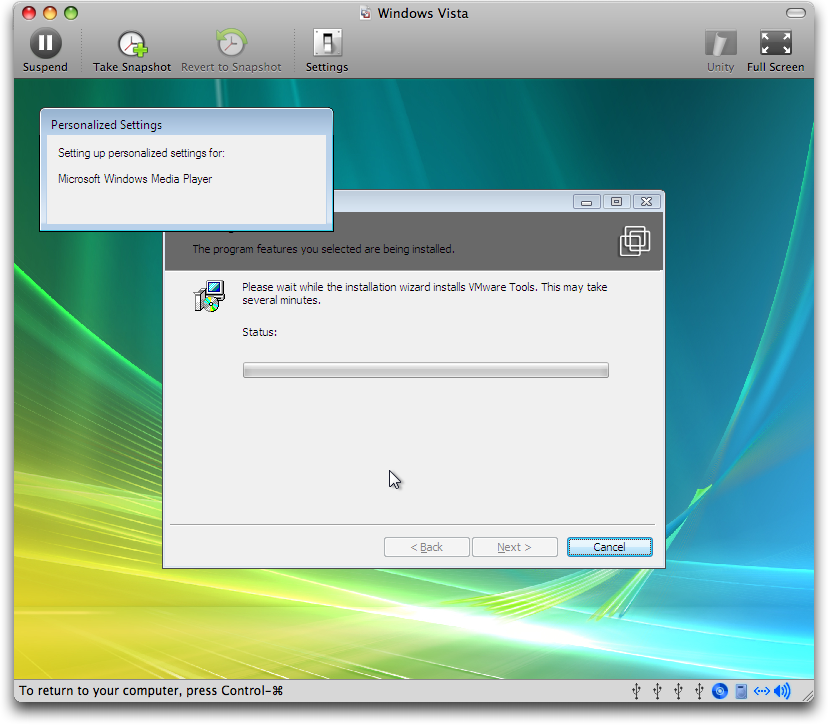After publishing my recent article on automating the silent installation of VMware Tools for Linux guestOSes, I received a similar question regarding Mac OS X guests and whether the existing script would also apply. The answer is no since Mac OS X packages differ from the Linux installres, but it is.
- Best fix for display resolution is to get the darwin.iso containing the Mac VMWare tools from a VMWare Fusion installation off a MAc (it’s under Library/ApplicationSupport/Images. It's actually under /Library/Application Support/VMware Fusion/isoimages on an OS X machine with VMware Fusion installed.
- In this article, I am going to show you how to install VMware tools on Mac OS X El Capitan. Have you ever installed Mac OS X El on Virtual Machine (VM) like VMware or virtualBox? If you are new then don’t worry I will leave the links below to install it on Virtual Machine. But if you’re not.
These advanced steps are primarily for system administrators and others who are familiar with the command line. You don't need a bootable installer to install macOS, but it can be useful when you want to install macOS on multiple computers without downloading the installer each time.
Download macOS
- Download a macOS installer, such as macOS Mojave or macOS High Sierra.
To download macOS Mojave or High Sierra for this purpose, download from a Mac that is using macOS Sierra 10.12.5 or later, or El Capitan 10.11.6. Enterprise administrators, please download from Apple, not a locally hosted software-update server. - When the macOS installer opens, quit it without continuing installation.
- Find the installer in your Applications folder as a single ”Install” file, such as Install macOS Mojave.
Mac Os X Manual Vmware Tools Install Centos
Use the 'createinstallmedia' command in Terminal
- After downloading the installer, connect the USB flash drive or other volume you're using for the bootable installer. Make sure that it has at least 12GB of available storage and is formatted as Mac OS Extended.
- Open Terminal, which is in the Utilities folder of your Applications folder.
- Type or paste one of the following commands in Terminal. These assume that the installer is still in your Applications folder, and MyVolume is the name of the USB flash drive or other volume you're using. If it has a different name, replace
MyVolumeaccordingly.
Mojave:*
High Sierra:*
Sierra:
El Capitan: - Press Return after typing the command.
- When prompted, type your administrator password and press Return again. Terminal doesn't show any characters as you type your password.
- When prompted, type
Yto confirm that you want to erase the volume, then press Return. Terminal shows the progress as the bootable installer is created. - When Terminal says that it's done, the volume will have the same name as the installer you downloaded, such as Install macOS Mojave. You can now quit Terminal and eject the volume.
* If your Mac is using macOS Sierra or earlier, include the --applicationpath argument. The Sierra and El Capitan commands show the proper format of this argument.
Use the bootable installer
After creating the bootable installer, follow these steps to use it.
- Connect the bootable installer to a compatible Mac.
- Use Startup Manager or Startup Disk preferences to select the bootable installer as the startup disk, then start up from it. Your Mac will start up to macOS Recovery.
Learn about selecting a startup disk, including what to do if your Mac doesn't start up from it. - Choose your language, if prompted.
- A bootable installer doesn't download macOS from the Internet, but it does require the Internet to get information specific to your Mac model, such as firmware updates. If you need to connect to a Wi-Fi network, use the Wi-Fi menu in the menu bar.
- Select Install macOS (or Install OS X) from the Utilities window, then click Continue and follow the onscreen instructions.
Learn more
For more information about the createinstallmedia command and the arguments that you can use with it, make sure that the macOS installer is in your Applications folder, then enter this path in Terminal:

Mojave:
High Sierra:
Sierra:
El Capitan:
For Mac OS X virtual machines you install or upgrade VMware Tools using an installer assistant.
If you use VMware Fusion or ESXi on a computer with an Apple label, you can create Mac OS X Server (10.5 or later) virtual machines and install VMware Tools.
Power on the virtual machine.
Verify that the guest operating system is running.
Procedure


- Select the menu command to mount and open the VMware Tools virtual disc on the guest operating system.
vSphere Client
Inventory > Virtual Machine > Guest > Install/Upgrade VMware Tools and select Interactive Tools Installation or Interactive Tools Upgrade
vSphere Web Client
Right-click the virtual machine in the vCenter inventory and select All vCenter Actions > Guest OS > Install/Upgrade VMware Tools
Fusion
Virtual Machine > Install (or Upgrade) VMware Tools
- Open Install VMware Tools on the VMware Tools virtual disc, follow the prompts in the installer assistant, and click OK.
Mac Os X Manual Vmware Tools Install Error
The virtual machine restarts to have VMware Tools take effect.